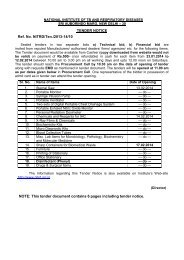October - LRS Institute of Tuberculosis & Respiratory Diseases
October - LRS Institute of Tuberculosis & Respiratory Diseases
October - LRS Institute of Tuberculosis & Respiratory Diseases
You also want an ePaper? Increase the reach of your titles
YUMPU automatically turns print PDFs into web optimized ePapers that Google loves.
LIVER ENZYMES DURING TREATMENT WITH RESERVE REGIMEN<br />
229<br />
TABLE 8<br />
Details <strong>of</strong> cases <strong>of</strong> Clinical Jaundice<br />
Sl. Age & Hb. Weight Pre-treatment level Duration Level <strong>of</strong> Inter- Regimn resumed or<br />
No. Sex (gm%) in kg <strong>of</strong> present serum repution not<br />
LDH SGPT Serum treatment bilirubin <strong>of</strong> treat-<br />
(I.U/ (I.U/ Alk. ment<br />
litre) litre) Phos.<br />
(K.A.<br />
Unit)<br />
1. 25 F 8.5 25 200.4 8.0 7.08 9 days 12 mg% 12 days Pyrazinamide omitted,<br />
Rifampicin & Ethambutol<br />
restarted. Patient<br />
tolerated well.<br />
2. 25 F 6.8 27 300.6 20.0 16.70 10 days 12.4 mg% 16 days Pyrazinamide omitted.<br />
Rifampicin and<br />
Ethambutol restarted.<br />
Tolerated well.<br />
3. 60 F 7.5 30 300.6 8.0 3.20 12 days 10.4mg% 18 days Rifampicin +<br />
Pyrazinamide +<br />
Ethambutol resumed<br />
but patient had raised<br />
LDH, SGPT and<br />
serum bilirubin at 60<br />
days <strong>of</strong> treatment and<br />
followed subsequently<br />
without any ill effect.<br />
alkaline phosphatase at 15 and 30 days <strong>of</strong><br />
treatment whereas fall in the levels by 60th day<br />
is significant.<br />
3 (12 %) cases developed clinical jaundice during<br />
this study. Pre-treatment levels <strong>of</strong> liver<br />
enzymes, under study, are as shown in Table<br />
8. All were females and their duration <strong>of</strong> treatment<br />
was from 9 to 12 days (mean 10 days)<br />
indicating the average time for clinical jaundice.<br />
Interruption <strong>of</strong> treatment was from 12 to 18<br />
days (mean 15 days). All were severely malnourished,<br />
almost half <strong>of</strong> the average weight. One<br />
<strong>of</strong> them was severely anaemic (6.8 gm% haemoglobin)<br />
and the two others had moderate<br />
anaemia with 7.5 gm% and 8,5 gm % haemoglobin.<br />
One (4%) continued with the regimen and<br />
had raised values <strong>of</strong> LDH and SGPT and serum<br />
bilirubin at the end <strong>of</strong> 60 days <strong>of</strong> treatment and<br />
followed up subsequently without any ill effect.<br />
2(8%) had pyrazinamide omitted thinking that<br />
this drug might be responsible for damage to<br />
the liver and rifampicin and ethambutol were restarted<br />
without any ill effect. It can be concluded<br />
that this regimen should be used with<br />
great caution in those who have demonstrable<br />
hepatic dysfunction.<br />
Discussion<br />
Serum lactate dehydrogenase and serum<br />
glutamic pyruvic transaminase were used as<br />
an index <strong>of</strong> hepatocellular damage and serum<br />
alkaline phosphatase was used as an index<br />
for cholestasis. Litchman (1953) pointed out<br />
that in pulmonary tuberculosis clinical observations<br />
demonstrate a lack <strong>of</strong> parenchyma] hepatic<br />
damage contrary to the presence <strong>of</strong> such hepatic<br />
damage as revealed by sensitive hepatic tests,<br />
In our study also, none <strong>of</strong> the patients had any<br />
clinical signs <strong>of</strong> involvement <strong>of</strong> the liver or<br />
jaundice before the start <strong>of</strong> treatment though<br />
subclinical involvement <strong>of</strong> the liver was there<br />
as is revealed by the pre-treatment liver<br />
enzyme levels in the abnormal group.<br />
It can be concluded from the given data<br />
that mean enzyme activity in abnormal group<br />
start falling after treatment by 30th day onwards<br />
whereas in normal group, mean enzyme activity<br />
Ind. J. Tub., Vol. XXIX, No. 4

















